Leadership in Business: Global Mindset, Marketing and Credos Analysis
VerifiedAdded on 2020/04/15
|13
|3629
|42
Report
AI Summary
This report provides a comprehensive analysis of leadership in business, drawing insights from a global mindset assessment. It explores the importance of intellectual, psychological, and social capital in adapting to a globalized business environment. The report delves into the author's personal assessment results, highlighting strengths in social capital, and discusses the potential for improvement across all dimensions. It outlines steps to enhance leadership practices, including identifying strengths and weaknesses, developing key skills, and aligning individual abilities with organizational requirements. Furthermore, the report examines different marketing approaches (1.0, 2.0, and 3.0) and their implications for leadership, focusing on product-centered, consumer-oriented, and values-driven strategies. Finally, it analyzes the alignment of leadership experience and practice with the 10 credos of marketing 3.0, emphasizing the importance of a global mindset, stakeholder engagement, and a service-oriented approach to leadership.
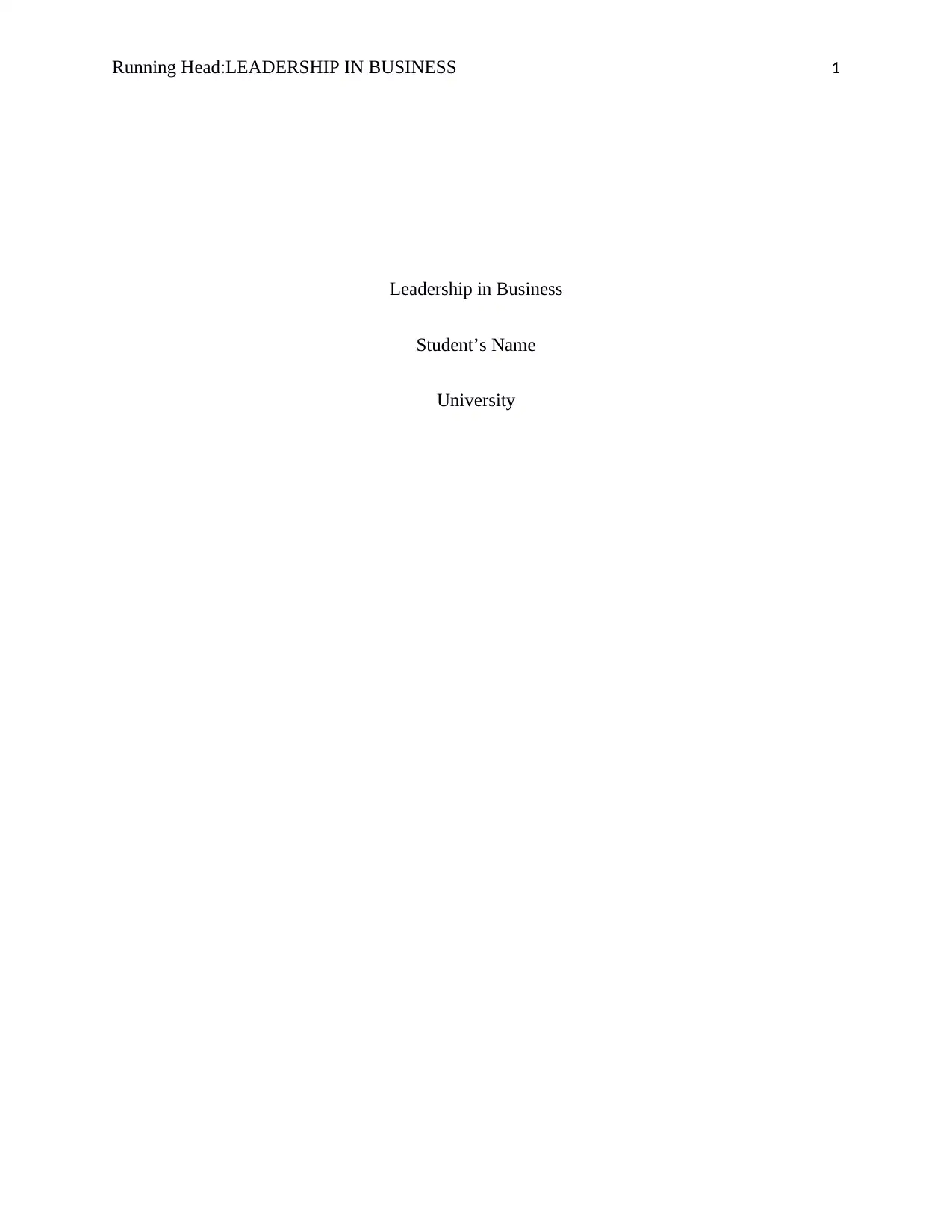
Running Head:LEADERSHIP IN BUSINESS 1
Leadership in Business
Student’s Name
University
Leadership in Business
Student’s Name
University
Paraphrase This Document
Need a fresh take? Get an instant paraphrase of this document with our AI Paraphraser
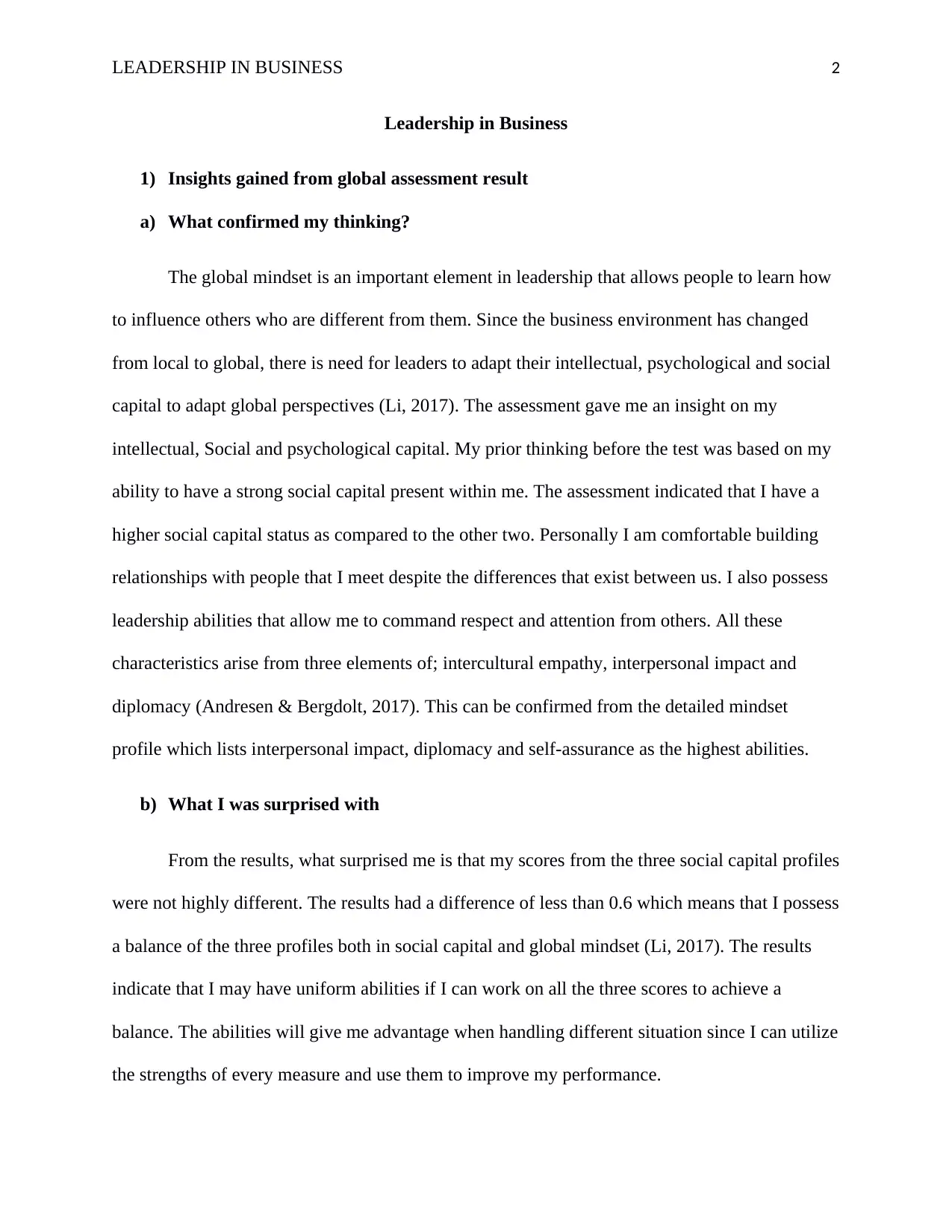
LEADERSHIP IN BUSINESS 2
Leadership in Business
1) Insights gained from global assessment result
a) What confirmed my thinking?
The global mindset is an important element in leadership that allows people to learn how
to influence others who are different from them. Since the business environment has changed
from local to global, there is need for leaders to adapt their intellectual, psychological and social
capital to adapt global perspectives (Li, 2017). The assessment gave me an insight on my
intellectual, Social and psychological capital. My prior thinking before the test was based on my
ability to have a strong social capital present within me. The assessment indicated that I have a
higher social capital status as compared to the other two. Personally I am comfortable building
relationships with people that I meet despite the differences that exist between us. I also possess
leadership abilities that allow me to command respect and attention from others. All these
characteristics arise from three elements of; intercultural empathy, interpersonal impact and
diplomacy (Andresen & Bergdolt, 2017). This can be confirmed from the detailed mindset
profile which lists interpersonal impact, diplomacy and self-assurance as the highest abilities.
b) What I was surprised with
From the results, what surprised me is that my scores from the three social capital profiles
were not highly different. The results had a difference of less than 0.6 which means that I possess
a balance of the three profiles both in social capital and global mindset (Li, 2017). The results
indicate that I may have uniform abilities if I can work on all the three scores to achieve a
balance. The abilities will give me advantage when handling different situation since I can utilize
the strengths of every measure and use them to improve my performance.
Leadership in Business
1) Insights gained from global assessment result
a) What confirmed my thinking?
The global mindset is an important element in leadership that allows people to learn how
to influence others who are different from them. Since the business environment has changed
from local to global, there is need for leaders to adapt their intellectual, psychological and social
capital to adapt global perspectives (Li, 2017). The assessment gave me an insight on my
intellectual, Social and psychological capital. My prior thinking before the test was based on my
ability to have a strong social capital present within me. The assessment indicated that I have a
higher social capital status as compared to the other two. Personally I am comfortable building
relationships with people that I meet despite the differences that exist between us. I also possess
leadership abilities that allow me to command respect and attention from others. All these
characteristics arise from three elements of; intercultural empathy, interpersonal impact and
diplomacy (Andresen & Bergdolt, 2017). This can be confirmed from the detailed mindset
profile which lists interpersonal impact, diplomacy and self-assurance as the highest abilities.
b) What I was surprised with
From the results, what surprised me is that my scores from the three social capital profiles
were not highly different. The results had a difference of less than 0.6 which means that I possess
a balance of the three profiles both in social capital and global mindset (Li, 2017). The results
indicate that I may have uniform abilities if I can work on all the three scores to achieve a
balance. The abilities will give me advantage when handling different situation since I can utilize
the strengths of every measure and use them to improve my performance.
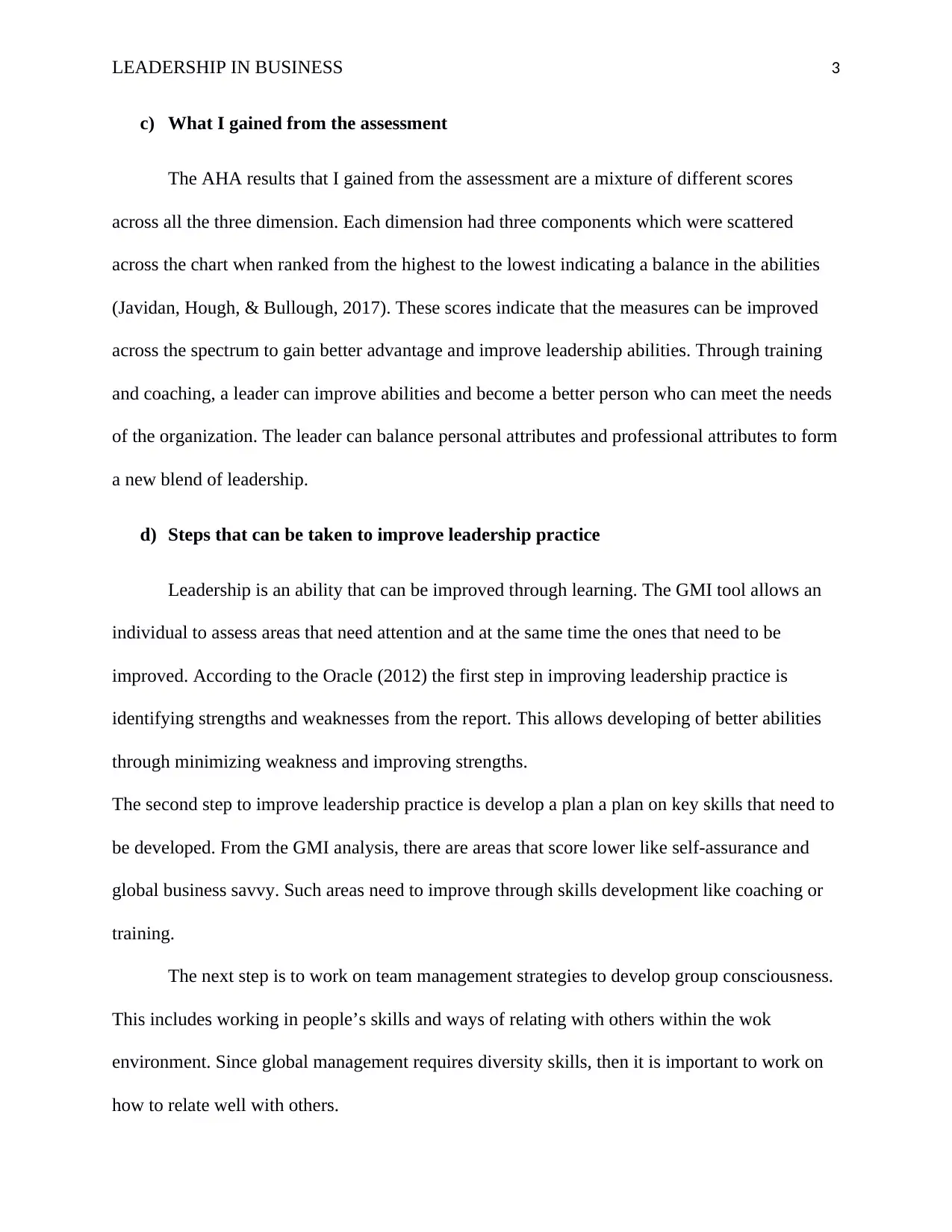
LEADERSHIP IN BUSINESS 3
c) What I gained from the assessment
The AHA results that I gained from the assessment are a mixture of different scores
across all the three dimension. Each dimension had three components which were scattered
across the chart when ranked from the highest to the lowest indicating a balance in the abilities
(Javidan, Hough, & Bullough, 2017). These scores indicate that the measures can be improved
across the spectrum to gain better advantage and improve leadership abilities. Through training
and coaching, a leader can improve abilities and become a better person who can meet the needs
of the organization. The leader can balance personal attributes and professional attributes to form
a new blend of leadership.
d) Steps that can be taken to improve leadership practice
Leadership is an ability that can be improved through learning. The GMI tool allows an
individual to assess areas that need attention and at the same time the ones that need to be
improved. According to the Oracle (2012) the first step in improving leadership practice is
identifying strengths and weaknesses from the report. This allows developing of better abilities
through minimizing weakness and improving strengths.
The second step to improve leadership practice is develop a plan a plan on key skills that need to
be developed. From the GMI analysis, there are areas that score lower like self-assurance and
global business savvy. Such areas need to improve through skills development like coaching or
training.
The next step is to work on team management strategies to develop group consciousness.
This includes working in people’s skills and ways of relating with others within the wok
environment. Since global management requires diversity skills, then it is important to work on
how to relate well with others.
c) What I gained from the assessment
The AHA results that I gained from the assessment are a mixture of different scores
across all the three dimension. Each dimension had three components which were scattered
across the chart when ranked from the highest to the lowest indicating a balance in the abilities
(Javidan, Hough, & Bullough, 2017). These scores indicate that the measures can be improved
across the spectrum to gain better advantage and improve leadership abilities. Through training
and coaching, a leader can improve abilities and become a better person who can meet the needs
of the organization. The leader can balance personal attributes and professional attributes to form
a new blend of leadership.
d) Steps that can be taken to improve leadership practice
Leadership is an ability that can be improved through learning. The GMI tool allows an
individual to assess areas that need attention and at the same time the ones that need to be
improved. According to the Oracle (2012) the first step in improving leadership practice is
identifying strengths and weaknesses from the report. This allows developing of better abilities
through minimizing weakness and improving strengths.
The second step to improve leadership practice is develop a plan a plan on key skills that need to
be developed. From the GMI analysis, there are areas that score lower like self-assurance and
global business savvy. Such areas need to improve through skills development like coaching or
training.
The next step is to work on team management strategies to develop group consciousness.
This includes working in people’s skills and ways of relating with others within the wok
environment. Since global management requires diversity skills, then it is important to work on
how to relate well with others.
⊘ This is a preview!⊘
Do you want full access?
Subscribe today to unlock all pages.

Trusted by 1+ million students worldwide
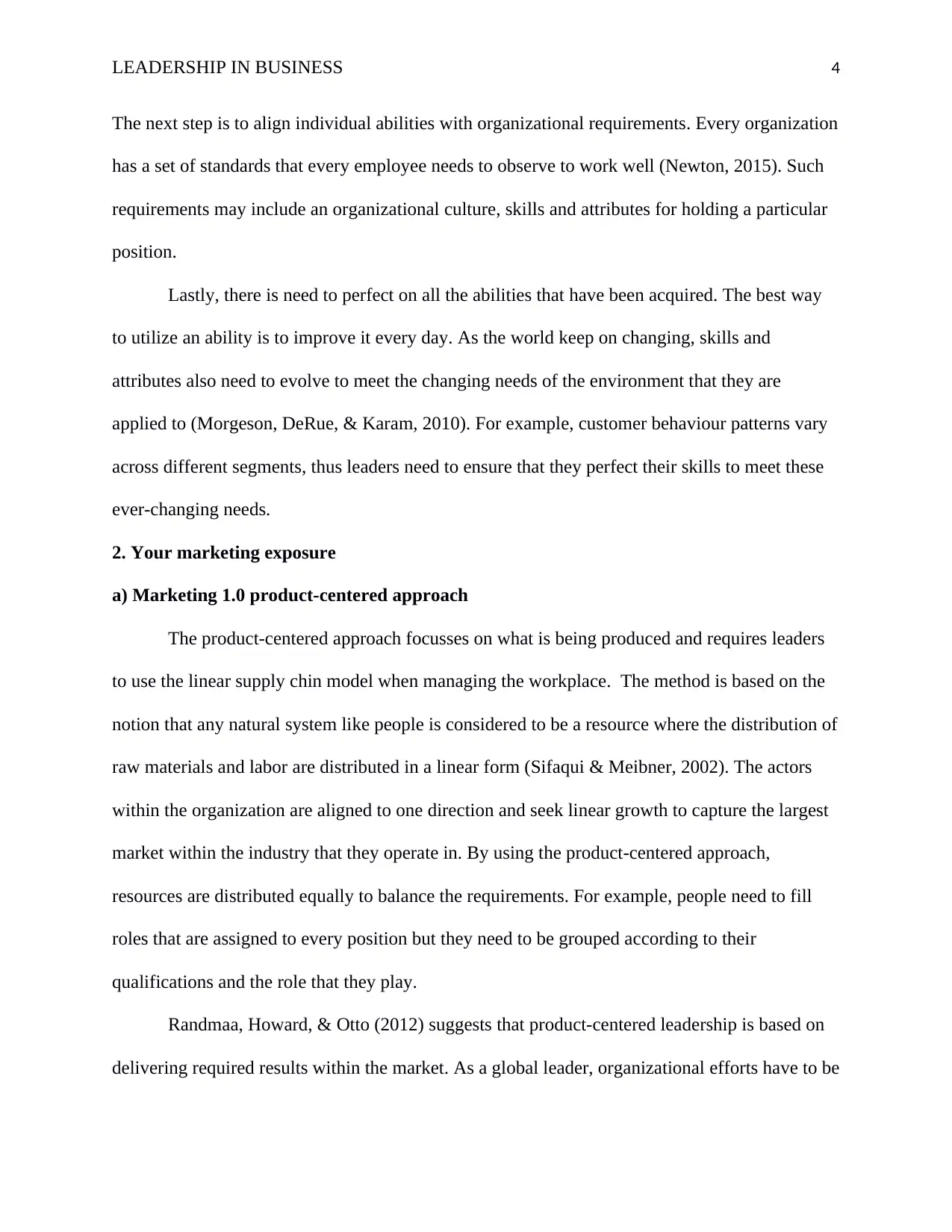
LEADERSHIP IN BUSINESS 4
The next step is to align individual abilities with organizational requirements. Every organization
has a set of standards that every employee needs to observe to work well (Newton, 2015). Such
requirements may include an organizational culture, skills and attributes for holding a particular
position.
Lastly, there is need to perfect on all the abilities that have been acquired. The best way
to utilize an ability is to improve it every day. As the world keep on changing, skills and
attributes also need to evolve to meet the changing needs of the environment that they are
applied to (Morgeson, DeRue, & Karam, 2010). For example, customer behaviour patterns vary
across different segments, thus leaders need to ensure that they perfect their skills to meet these
ever-changing needs.
2. Your marketing exposure
a) Marketing 1.0 product-centered approach
The product-centered approach focusses on what is being produced and requires leaders
to use the linear supply chin model when managing the workplace. The method is based on the
notion that any natural system like people is considered to be a resource where the distribution of
raw materials and labor are distributed in a linear form (Sifaqui & Meibner, 2002). The actors
within the organization are aligned to one direction and seek linear growth to capture the largest
market within the industry that they operate in. By using the product-centered approach,
resources are distributed equally to balance the requirements. For example, people need to fill
roles that are assigned to every position but they need to be grouped according to their
qualifications and the role that they play.
Randmaa, Howard, & Otto (2012) suggests that product-centered leadership is based on
delivering required results within the market. As a global leader, organizational efforts have to be
The next step is to align individual abilities with organizational requirements. Every organization
has a set of standards that every employee needs to observe to work well (Newton, 2015). Such
requirements may include an organizational culture, skills and attributes for holding a particular
position.
Lastly, there is need to perfect on all the abilities that have been acquired. The best way
to utilize an ability is to improve it every day. As the world keep on changing, skills and
attributes also need to evolve to meet the changing needs of the environment that they are
applied to (Morgeson, DeRue, & Karam, 2010). For example, customer behaviour patterns vary
across different segments, thus leaders need to ensure that they perfect their skills to meet these
ever-changing needs.
2. Your marketing exposure
a) Marketing 1.0 product-centered approach
The product-centered approach focusses on what is being produced and requires leaders
to use the linear supply chin model when managing the workplace. The method is based on the
notion that any natural system like people is considered to be a resource where the distribution of
raw materials and labor are distributed in a linear form (Sifaqui & Meibner, 2002). The actors
within the organization are aligned to one direction and seek linear growth to capture the largest
market within the industry that they operate in. By using the product-centered approach,
resources are distributed equally to balance the requirements. For example, people need to fill
roles that are assigned to every position but they need to be grouped according to their
qualifications and the role that they play.
Randmaa, Howard, & Otto (2012) suggests that product-centered leadership is based on
delivering required results within the market. As a global leader, organizational efforts have to be
Paraphrase This Document
Need a fresh take? Get an instant paraphrase of this document with our AI Paraphraser
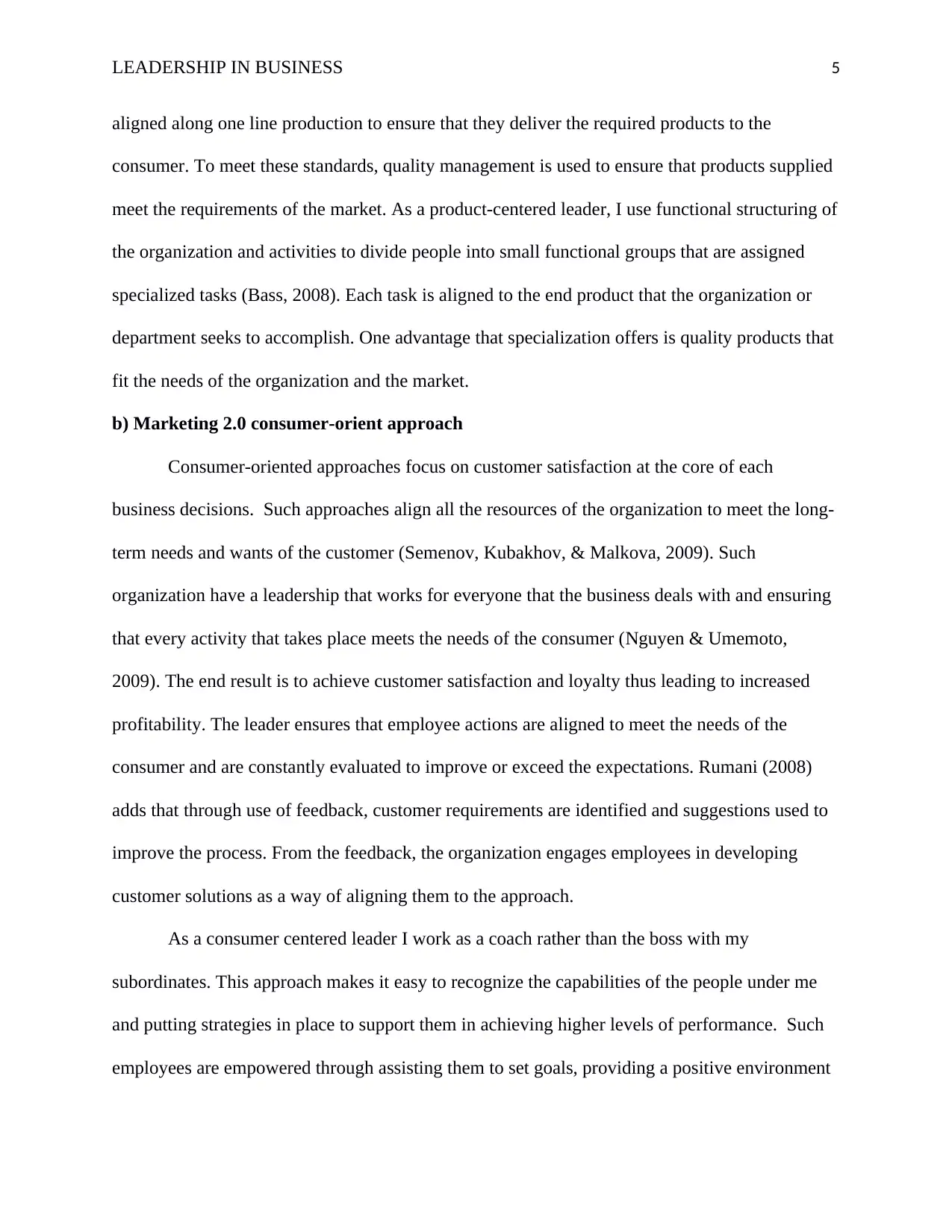
LEADERSHIP IN BUSINESS 5
aligned along one line production to ensure that they deliver the required products to the
consumer. To meet these standards, quality management is used to ensure that products supplied
meet the requirements of the market. As a product-centered leader, I use functional structuring of
the organization and activities to divide people into small functional groups that are assigned
specialized tasks (Bass, 2008). Each task is aligned to the end product that the organization or
department seeks to accomplish. One advantage that specialization offers is quality products that
fit the needs of the organization and the market.
b) Marketing 2.0 consumer-orient approach
Consumer-oriented approaches focus on customer satisfaction at the core of each
business decisions. Such approaches align all the resources of the organization to meet the long-
term needs and wants of the customer (Semenov, Kubakhov, & Malkova, 2009). Such
organization have a leadership that works for everyone that the business deals with and ensuring
that every activity that takes place meets the needs of the consumer (Nguyen & Umemoto,
2009). The end result is to achieve customer satisfaction and loyalty thus leading to increased
profitability. The leader ensures that employee actions are aligned to meet the needs of the
consumer and are constantly evaluated to improve or exceed the expectations. Rumani (2008)
adds that through use of feedback, customer requirements are identified and suggestions used to
improve the process. From the feedback, the organization engages employees in developing
customer solutions as a way of aligning them to the approach.
As a consumer centered leader I work as a coach rather than the boss with my
subordinates. This approach makes it easy to recognize the capabilities of the people under me
and putting strategies in place to support them in achieving higher levels of performance. Such
employees are empowered through assisting them to set goals, providing a positive environment
aligned along one line production to ensure that they deliver the required products to the
consumer. To meet these standards, quality management is used to ensure that products supplied
meet the requirements of the market. As a product-centered leader, I use functional structuring of
the organization and activities to divide people into small functional groups that are assigned
specialized tasks (Bass, 2008). Each task is aligned to the end product that the organization or
department seeks to accomplish. One advantage that specialization offers is quality products that
fit the needs of the organization and the market.
b) Marketing 2.0 consumer-orient approach
Consumer-oriented approaches focus on customer satisfaction at the core of each
business decisions. Such approaches align all the resources of the organization to meet the long-
term needs and wants of the customer (Semenov, Kubakhov, & Malkova, 2009). Such
organization have a leadership that works for everyone that the business deals with and ensuring
that every activity that takes place meets the needs of the consumer (Nguyen & Umemoto,
2009). The end result is to achieve customer satisfaction and loyalty thus leading to increased
profitability. The leader ensures that employee actions are aligned to meet the needs of the
consumer and are constantly evaluated to improve or exceed the expectations. Rumani (2008)
adds that through use of feedback, customer requirements are identified and suggestions used to
improve the process. From the feedback, the organization engages employees in developing
customer solutions as a way of aligning them to the approach.
As a consumer centered leader I work as a coach rather than the boss with my
subordinates. This approach makes it easy to recognize the capabilities of the people under me
and putting strategies in place to support them in achieving higher levels of performance. Such
employees are empowered through assisting them to set goals, providing a positive environment
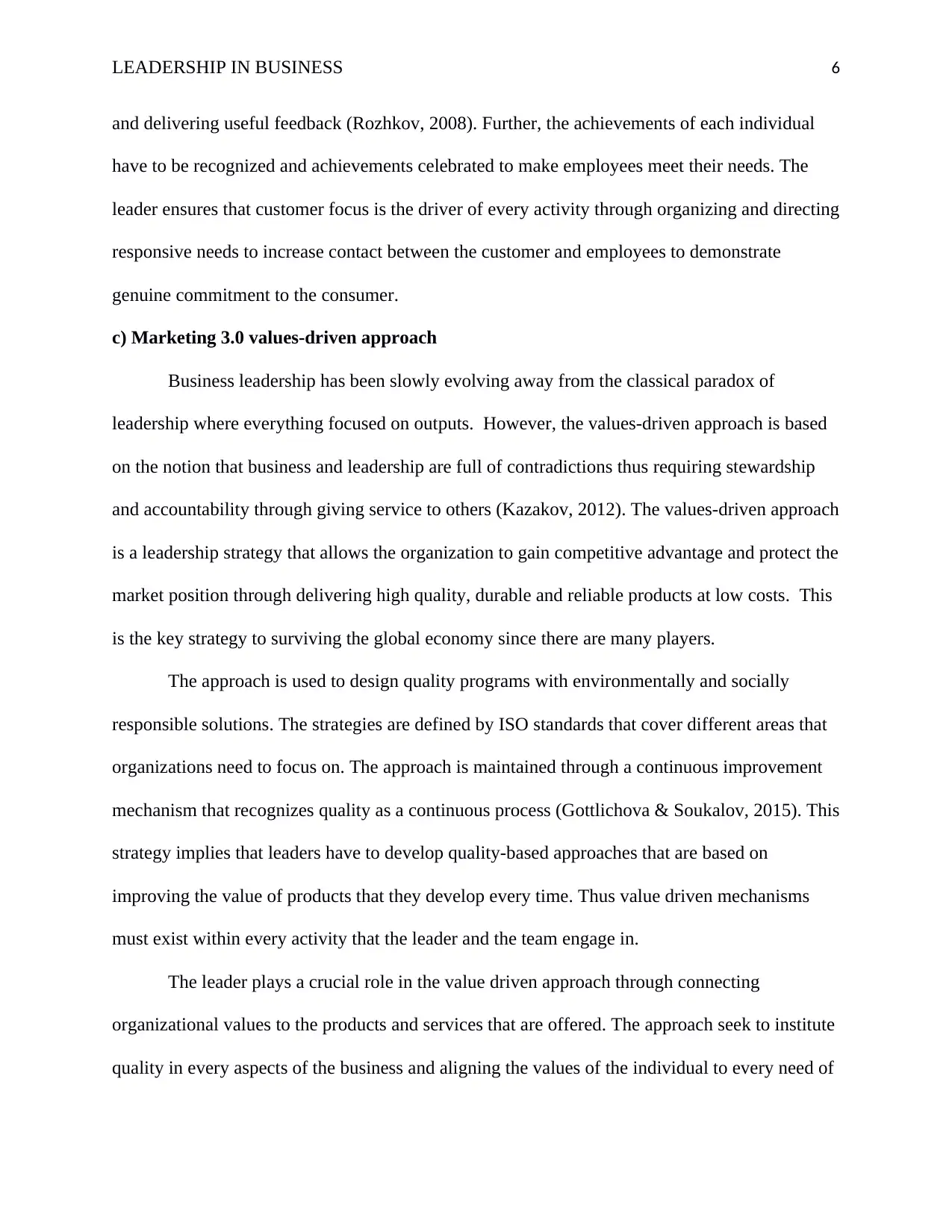
LEADERSHIP IN BUSINESS 6
and delivering useful feedback (Rozhkov, 2008). Further, the achievements of each individual
have to be recognized and achievements celebrated to make employees meet their needs. The
leader ensures that customer focus is the driver of every activity through organizing and directing
responsive needs to increase contact between the customer and employees to demonstrate
genuine commitment to the consumer.
c) Marketing 3.0 values-driven approach
Business leadership has been slowly evolving away from the classical paradox of
leadership where everything focused on outputs. However, the values-driven approach is based
on the notion that business and leadership are full of contradictions thus requiring stewardship
and accountability through giving service to others (Kazakov, 2012). The values-driven approach
is a leadership strategy that allows the organization to gain competitive advantage and protect the
market position through delivering high quality, durable and reliable products at low costs. This
is the key strategy to surviving the global economy since there are many players.
The approach is used to design quality programs with environmentally and socially
responsible solutions. The strategies are defined by ISO standards that cover different areas that
organizations need to focus on. The approach is maintained through a continuous improvement
mechanism that recognizes quality as a continuous process (Gottlichova & Soukalov, 2015). This
strategy implies that leaders have to develop quality-based approaches that are based on
improving the value of products that they develop every time. Thus value driven mechanisms
must exist within every activity that the leader and the team engage in.
The leader plays a crucial role in the value driven approach through connecting
organizational values to the products and services that are offered. The approach seek to institute
quality in every aspects of the business and aligning the values of the individual to every need of
and delivering useful feedback (Rozhkov, 2008). Further, the achievements of each individual
have to be recognized and achievements celebrated to make employees meet their needs. The
leader ensures that customer focus is the driver of every activity through organizing and directing
responsive needs to increase contact between the customer and employees to demonstrate
genuine commitment to the consumer.
c) Marketing 3.0 values-driven approach
Business leadership has been slowly evolving away from the classical paradox of
leadership where everything focused on outputs. However, the values-driven approach is based
on the notion that business and leadership are full of contradictions thus requiring stewardship
and accountability through giving service to others (Kazakov, 2012). The values-driven approach
is a leadership strategy that allows the organization to gain competitive advantage and protect the
market position through delivering high quality, durable and reliable products at low costs. This
is the key strategy to surviving the global economy since there are many players.
The approach is used to design quality programs with environmentally and socially
responsible solutions. The strategies are defined by ISO standards that cover different areas that
organizations need to focus on. The approach is maintained through a continuous improvement
mechanism that recognizes quality as a continuous process (Gottlichova & Soukalov, 2015). This
strategy implies that leaders have to develop quality-based approaches that are based on
improving the value of products that they develop every time. Thus value driven mechanisms
must exist within every activity that the leader and the team engage in.
The leader plays a crucial role in the value driven approach through connecting
organizational values to the products and services that are offered. The approach seek to institute
quality in every aspects of the business and aligning the values of the individual to every need of
⊘ This is a preview!⊘
Do you want full access?
Subscribe today to unlock all pages.

Trusted by 1+ million students worldwide
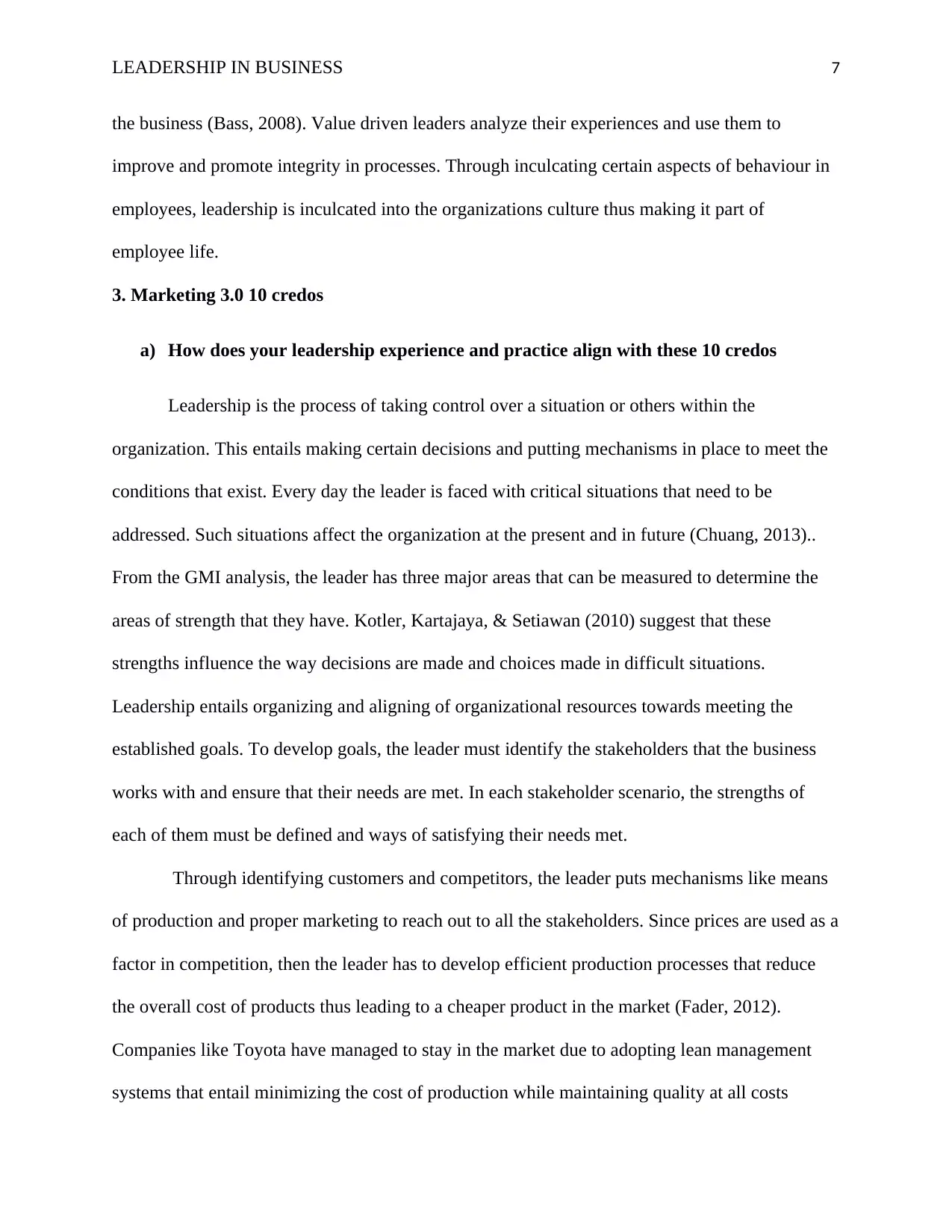
LEADERSHIP IN BUSINESS 7
the business (Bass, 2008). Value driven leaders analyze their experiences and use them to
improve and promote integrity in processes. Through inculcating certain aspects of behaviour in
employees, leadership is inculcated into the organizations culture thus making it part of
employee life.
3. Marketing 3.0 10 credos
a) How does your leadership experience and practice align with these 10 credos
Leadership is the process of taking control over a situation or others within the
organization. This entails making certain decisions and putting mechanisms in place to meet the
conditions that exist. Every day the leader is faced with critical situations that need to be
addressed. Such situations affect the organization at the present and in future (Chuang, 2013)..
From the GMI analysis, the leader has three major areas that can be measured to determine the
areas of strength that they have. Kotler, Kartajaya, & Setiawan (2010) suggest that these
strengths influence the way decisions are made and choices made in difficult situations.
Leadership entails organizing and aligning of organizational resources towards meeting the
established goals. To develop goals, the leader must identify the stakeholders that the business
works with and ensure that their needs are met. In each stakeholder scenario, the strengths of
each of them must be defined and ways of satisfying their needs met.
Through identifying customers and competitors, the leader puts mechanisms like means
of production and proper marketing to reach out to all the stakeholders. Since prices are used as a
factor in competition, then the leader has to develop efficient production processes that reduce
the overall cost of products thus leading to a cheaper product in the market (Fader, 2012).
Companies like Toyota have managed to stay in the market due to adopting lean management
systems that entail minimizing the cost of production while maintaining quality at all costs
the business (Bass, 2008). Value driven leaders analyze their experiences and use them to
improve and promote integrity in processes. Through inculcating certain aspects of behaviour in
employees, leadership is inculcated into the organizations culture thus making it part of
employee life.
3. Marketing 3.0 10 credos
a) How does your leadership experience and practice align with these 10 credos
Leadership is the process of taking control over a situation or others within the
organization. This entails making certain decisions and putting mechanisms in place to meet the
conditions that exist. Every day the leader is faced with critical situations that need to be
addressed. Such situations affect the organization at the present and in future (Chuang, 2013)..
From the GMI analysis, the leader has three major areas that can be measured to determine the
areas of strength that they have. Kotler, Kartajaya, & Setiawan (2010) suggest that these
strengths influence the way decisions are made and choices made in difficult situations.
Leadership entails organizing and aligning of organizational resources towards meeting the
established goals. To develop goals, the leader must identify the stakeholders that the business
works with and ensure that their needs are met. In each stakeholder scenario, the strengths of
each of them must be defined and ways of satisfying their needs met.
Through identifying customers and competitors, the leader puts mechanisms like means
of production and proper marketing to reach out to all the stakeholders. Since prices are used as a
factor in competition, then the leader has to develop efficient production processes that reduce
the overall cost of products thus leading to a cheaper product in the market (Fader, 2012).
Companies like Toyota have managed to stay in the market due to adopting lean management
systems that entail minimizing the cost of production while maintaining quality at all costs
Paraphrase This Document
Need a fresh take? Get an instant paraphrase of this document with our AI Paraphraser
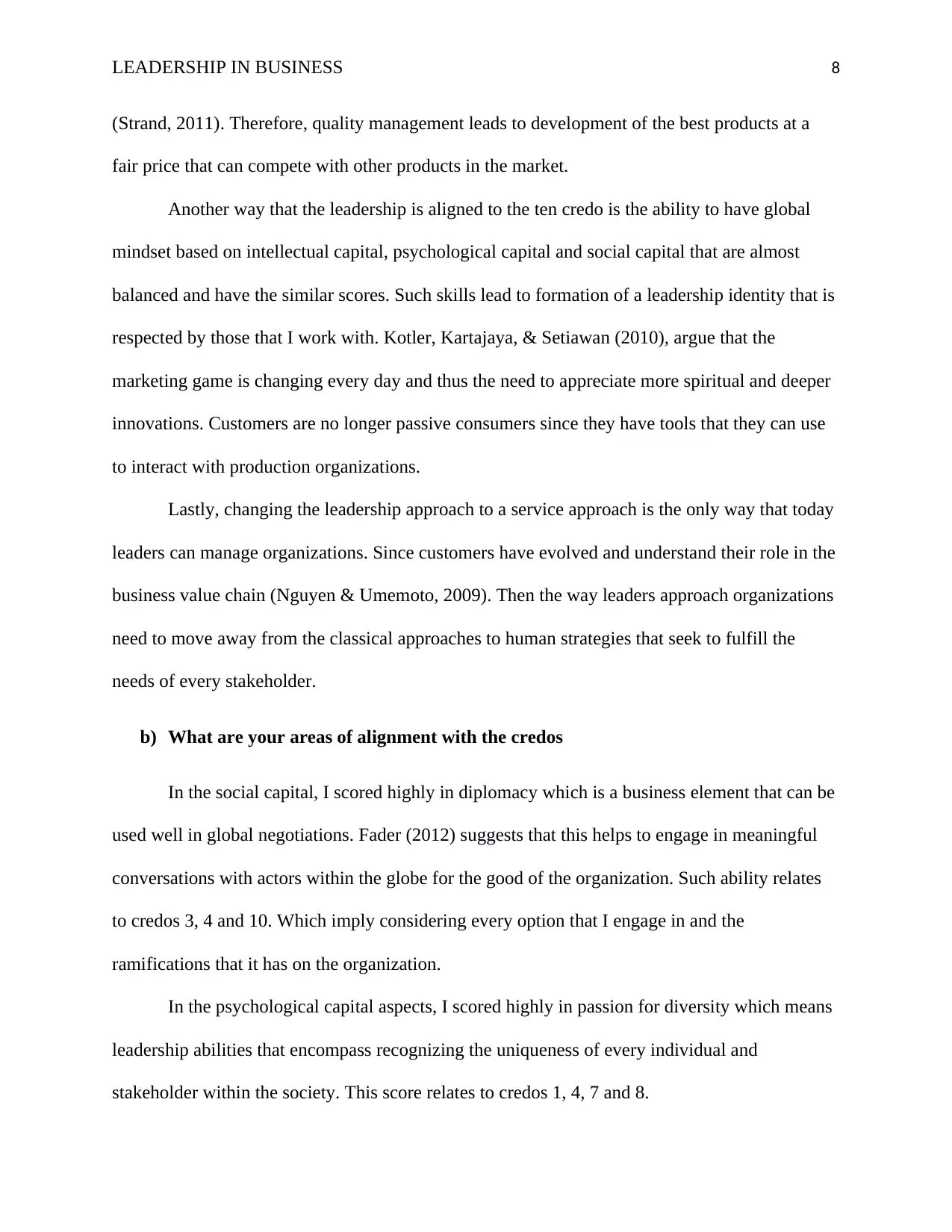
LEADERSHIP IN BUSINESS 8
(Strand, 2011). Therefore, quality management leads to development of the best products at a
fair price that can compete with other products in the market.
Another way that the leadership is aligned to the ten credo is the ability to have global
mindset based on intellectual capital, psychological capital and social capital that are almost
balanced and have the similar scores. Such skills lead to formation of a leadership identity that is
respected by those that I work with. Kotler, Kartajaya, & Setiawan (2010), argue that the
marketing game is changing every day and thus the need to appreciate more spiritual and deeper
innovations. Customers are no longer passive consumers since they have tools that they can use
to interact with production organizations.
Lastly, changing the leadership approach to a service approach is the only way that today
leaders can manage organizations. Since customers have evolved and understand their role in the
business value chain (Nguyen & Umemoto, 2009). Then the way leaders approach organizations
need to move away from the classical approaches to human strategies that seek to fulfill the
needs of every stakeholder.
b) What are your areas of alignment with the credos
In the social capital, I scored highly in diplomacy which is a business element that can be
used well in global negotiations. Fader (2012) suggests that this helps to engage in meaningful
conversations with actors within the globe for the good of the organization. Such ability relates
to credos 3, 4 and 10. Which imply considering every option that I engage in and the
ramifications that it has on the organization.
In the psychological capital aspects, I scored highly in passion for diversity which means
leadership abilities that encompass recognizing the uniqueness of every individual and
stakeholder within the society. This score relates to credos 1, 4, 7 and 8.
(Strand, 2011). Therefore, quality management leads to development of the best products at a
fair price that can compete with other products in the market.
Another way that the leadership is aligned to the ten credo is the ability to have global
mindset based on intellectual capital, psychological capital and social capital that are almost
balanced and have the similar scores. Such skills lead to formation of a leadership identity that is
respected by those that I work with. Kotler, Kartajaya, & Setiawan (2010), argue that the
marketing game is changing every day and thus the need to appreciate more spiritual and deeper
innovations. Customers are no longer passive consumers since they have tools that they can use
to interact with production organizations.
Lastly, changing the leadership approach to a service approach is the only way that today
leaders can manage organizations. Since customers have evolved and understand their role in the
business value chain (Nguyen & Umemoto, 2009). Then the way leaders approach organizations
need to move away from the classical approaches to human strategies that seek to fulfill the
needs of every stakeholder.
b) What are your areas of alignment with the credos
In the social capital, I scored highly in diplomacy which is a business element that can be
used well in global negotiations. Fader (2012) suggests that this helps to engage in meaningful
conversations with actors within the globe for the good of the organization. Such ability relates
to credos 3, 4 and 10. Which imply considering every option that I engage in and the
ramifications that it has on the organization.
In the psychological capital aspects, I scored highly in passion for diversity which means
leadership abilities that encompass recognizing the uniqueness of every individual and
stakeholder within the society. This score relates to credos 1, 4, 7 and 8.
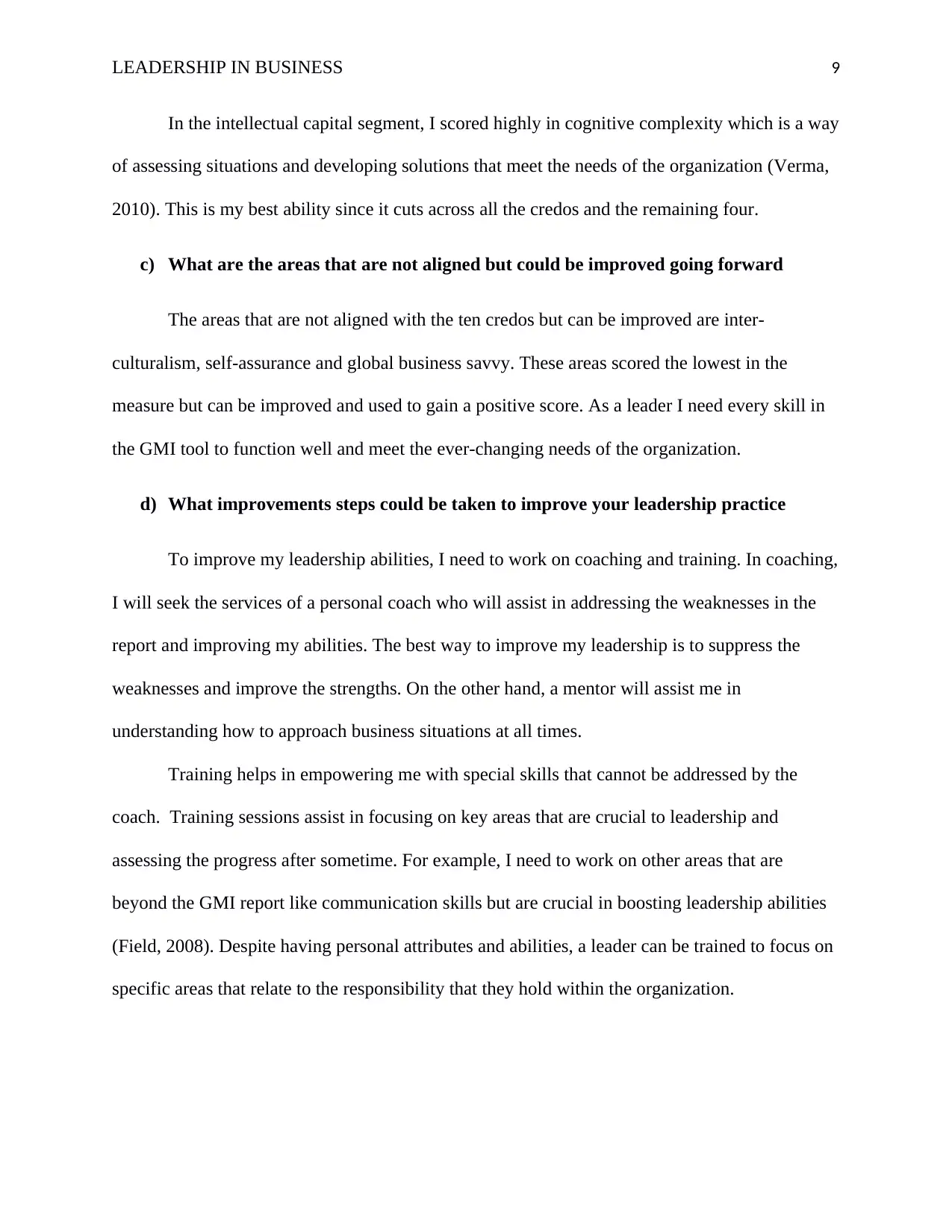
LEADERSHIP IN BUSINESS 9
In the intellectual capital segment, I scored highly in cognitive complexity which is a way
of assessing situations and developing solutions that meet the needs of the organization (Verma,
2010). This is my best ability since it cuts across all the credos and the remaining four.
c) What are the areas that are not aligned but could be improved going forward
The areas that are not aligned with the ten credos but can be improved are inter-
culturalism, self-assurance and global business savvy. These areas scored the lowest in the
measure but can be improved and used to gain a positive score. As a leader I need every skill in
the GMI tool to function well and meet the ever-changing needs of the organization.
d) What improvements steps could be taken to improve your leadership practice
To improve my leadership abilities, I need to work on coaching and training. In coaching,
I will seek the services of a personal coach who will assist in addressing the weaknesses in the
report and improving my abilities. The best way to improve my leadership is to suppress the
weaknesses and improve the strengths. On the other hand, a mentor will assist me in
understanding how to approach business situations at all times.
Training helps in empowering me with special skills that cannot be addressed by the
coach. Training sessions assist in focusing on key areas that are crucial to leadership and
assessing the progress after sometime. For example, I need to work on other areas that are
beyond the GMI report like communication skills but are crucial in boosting leadership abilities
(Field, 2008). Despite having personal attributes and abilities, a leader can be trained to focus on
specific areas that relate to the responsibility that they hold within the organization.
In the intellectual capital segment, I scored highly in cognitive complexity which is a way
of assessing situations and developing solutions that meet the needs of the organization (Verma,
2010). This is my best ability since it cuts across all the credos and the remaining four.
c) What are the areas that are not aligned but could be improved going forward
The areas that are not aligned with the ten credos but can be improved are inter-
culturalism, self-assurance and global business savvy. These areas scored the lowest in the
measure but can be improved and used to gain a positive score. As a leader I need every skill in
the GMI tool to function well and meet the ever-changing needs of the organization.
d) What improvements steps could be taken to improve your leadership practice
To improve my leadership abilities, I need to work on coaching and training. In coaching,
I will seek the services of a personal coach who will assist in addressing the weaknesses in the
report and improving my abilities. The best way to improve my leadership is to suppress the
weaknesses and improve the strengths. On the other hand, a mentor will assist me in
understanding how to approach business situations at all times.
Training helps in empowering me with special skills that cannot be addressed by the
coach. Training sessions assist in focusing on key areas that are crucial to leadership and
assessing the progress after sometime. For example, I need to work on other areas that are
beyond the GMI report like communication skills but are crucial in boosting leadership abilities
(Field, 2008). Despite having personal attributes and abilities, a leader can be trained to focus on
specific areas that relate to the responsibility that they hold within the organization.
⊘ This is a preview!⊘
Do you want full access?
Subscribe today to unlock all pages.

Trusted by 1+ million students worldwide
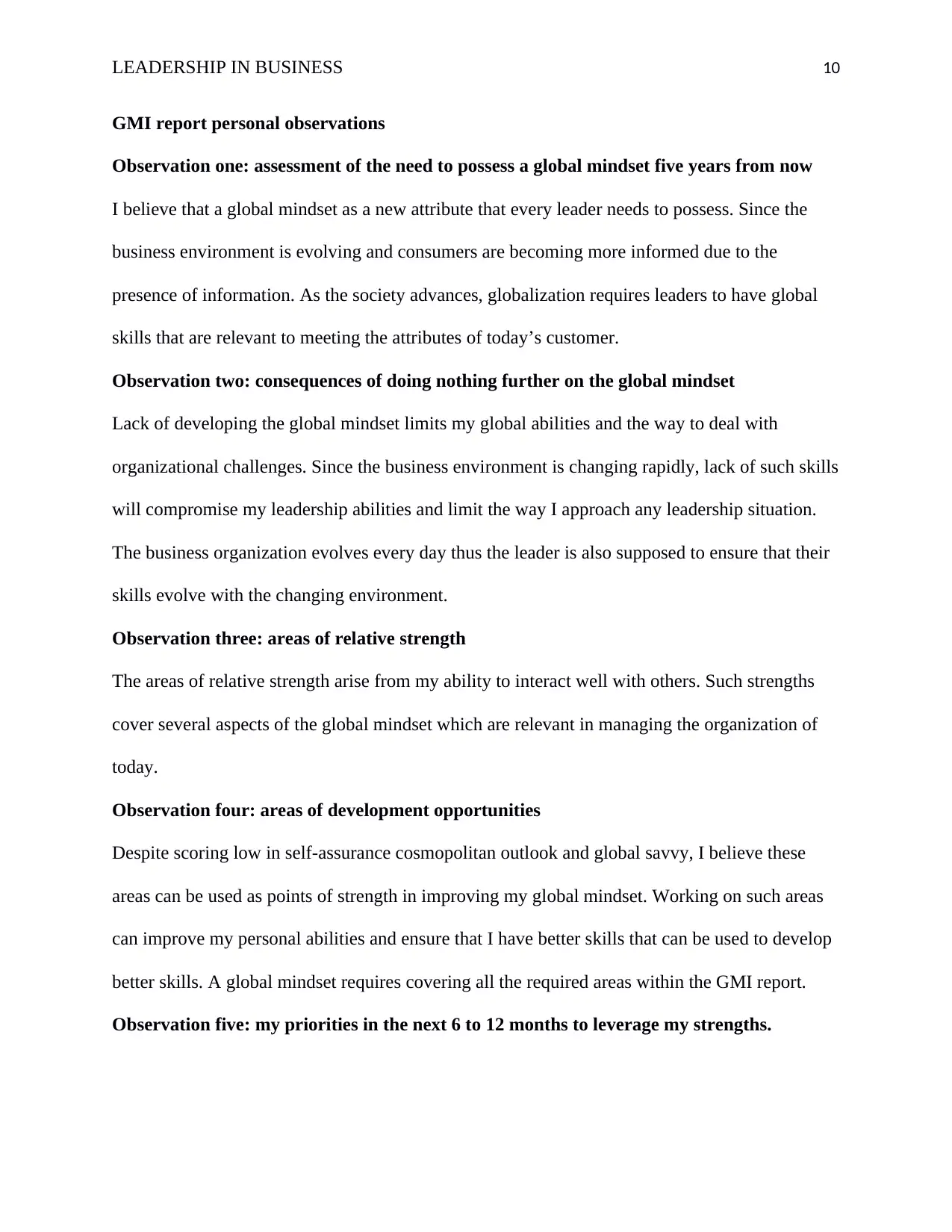
LEADERSHIP IN BUSINESS 10
GMI report personal observations
Observation one: assessment of the need to possess a global mindset five years from now
I believe that a global mindset as a new attribute that every leader needs to possess. Since the
business environment is evolving and consumers are becoming more informed due to the
presence of information. As the society advances, globalization requires leaders to have global
skills that are relevant to meeting the attributes of today’s customer.
Observation two: consequences of doing nothing further on the global mindset
Lack of developing the global mindset limits my global abilities and the way to deal with
organizational challenges. Since the business environment is changing rapidly, lack of such skills
will compromise my leadership abilities and limit the way I approach any leadership situation.
The business organization evolves every day thus the leader is also supposed to ensure that their
skills evolve with the changing environment.
Observation three: areas of relative strength
The areas of relative strength arise from my ability to interact well with others. Such strengths
cover several aspects of the global mindset which are relevant in managing the organization of
today.
Observation four: areas of development opportunities
Despite scoring low in self-assurance cosmopolitan outlook and global savvy, I believe these
areas can be used as points of strength in improving my global mindset. Working on such areas
can improve my personal abilities and ensure that I have better skills that can be used to develop
better skills. A global mindset requires covering all the required areas within the GMI report.
Observation five: my priorities in the next 6 to 12 months to leverage my strengths.
GMI report personal observations
Observation one: assessment of the need to possess a global mindset five years from now
I believe that a global mindset as a new attribute that every leader needs to possess. Since the
business environment is evolving and consumers are becoming more informed due to the
presence of information. As the society advances, globalization requires leaders to have global
skills that are relevant to meeting the attributes of today’s customer.
Observation two: consequences of doing nothing further on the global mindset
Lack of developing the global mindset limits my global abilities and the way to deal with
organizational challenges. Since the business environment is changing rapidly, lack of such skills
will compromise my leadership abilities and limit the way I approach any leadership situation.
The business organization evolves every day thus the leader is also supposed to ensure that their
skills evolve with the changing environment.
Observation three: areas of relative strength
The areas of relative strength arise from my ability to interact well with others. Such strengths
cover several aspects of the global mindset which are relevant in managing the organization of
today.
Observation four: areas of development opportunities
Despite scoring low in self-assurance cosmopolitan outlook and global savvy, I believe these
areas can be used as points of strength in improving my global mindset. Working on such areas
can improve my personal abilities and ensure that I have better skills that can be used to develop
better skills. A global mindset requires covering all the required areas within the GMI report.
Observation five: my priorities in the next 6 to 12 months to leverage my strengths.
Paraphrase This Document
Need a fresh take? Get an instant paraphrase of this document with our AI Paraphraser
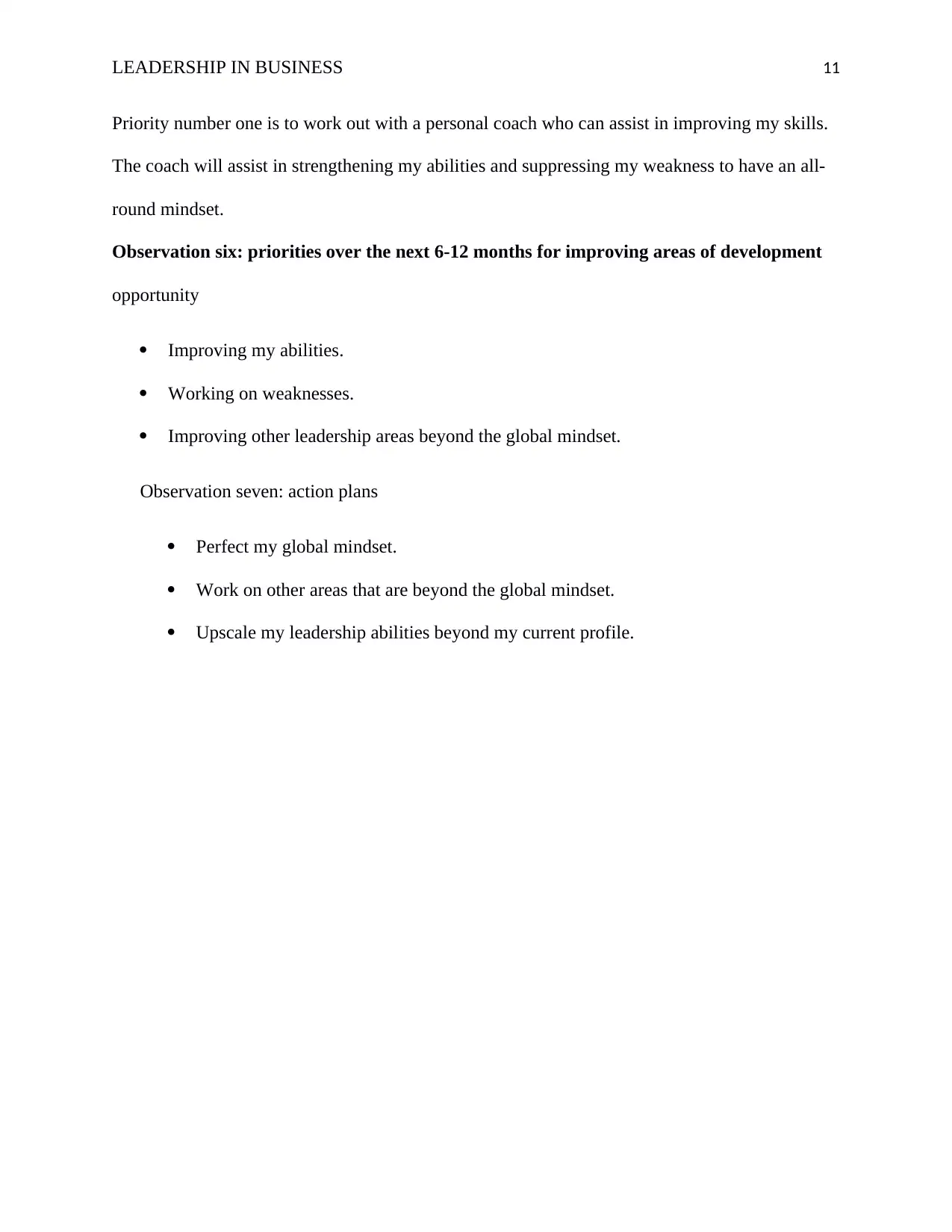
LEADERSHIP IN BUSINESS 11
Priority number one is to work out with a personal coach who can assist in improving my skills.
The coach will assist in strengthening my abilities and suppressing my weakness to have an all-
round mindset.
Observation six: priorities over the next 6-12 months for improving areas of development
opportunity
Improving my abilities.
Working on weaknesses.
Improving other leadership areas beyond the global mindset.
Observation seven: action plans
Perfect my global mindset.
Work on other areas that are beyond the global mindset.
Upscale my leadership abilities beyond my current profile.
Priority number one is to work out with a personal coach who can assist in improving my skills.
The coach will assist in strengthening my abilities and suppressing my weakness to have an all-
round mindset.
Observation six: priorities over the next 6-12 months for improving areas of development
opportunity
Improving my abilities.
Working on weaknesses.
Improving other leadership areas beyond the global mindset.
Observation seven: action plans
Perfect my global mindset.
Work on other areas that are beyond the global mindset.
Upscale my leadership abilities beyond my current profile.
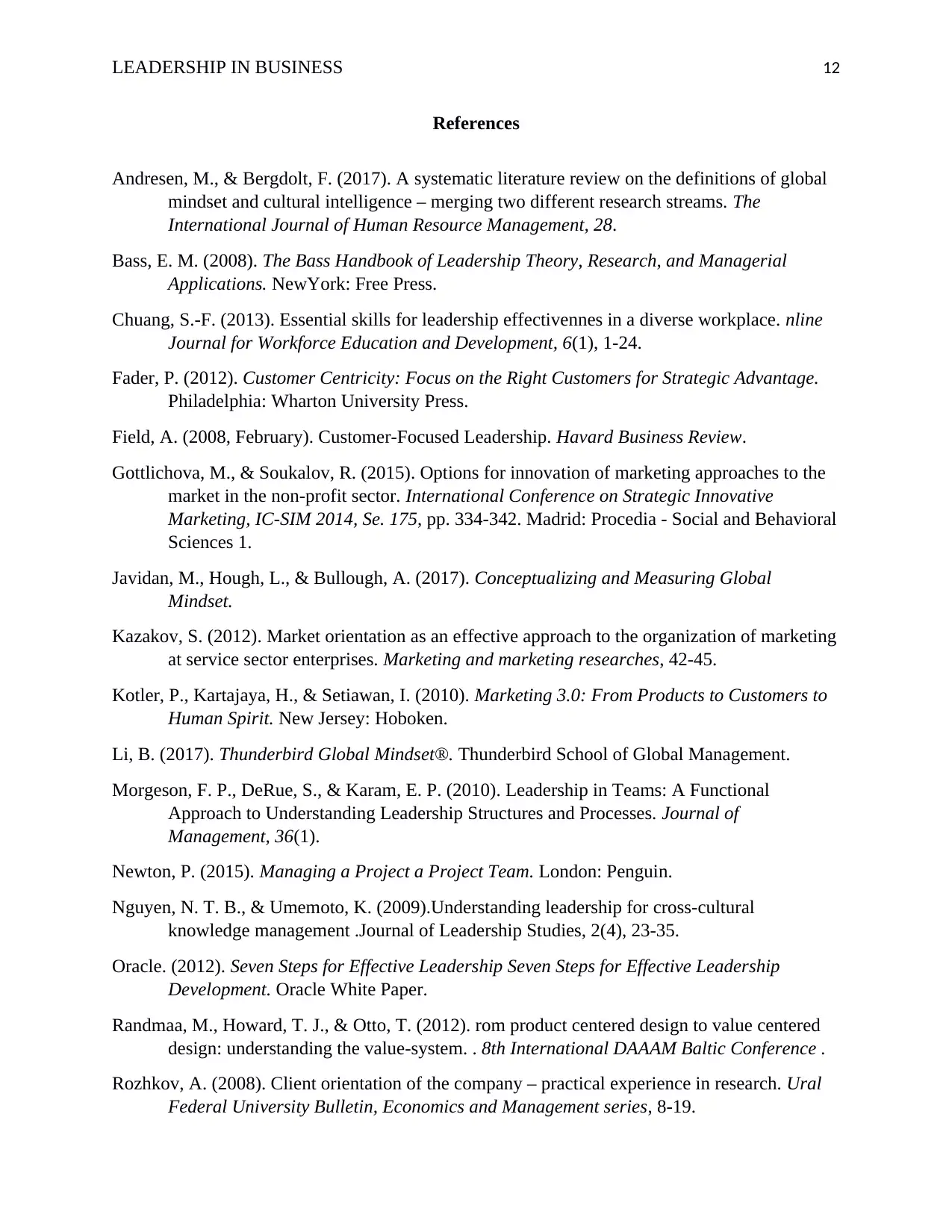
LEADERSHIP IN BUSINESS 12
References
Andresen, M., & Bergdolt, F. (2017). A systematic literature review on the definitions of global
mindset and cultural intelligence – merging two different research streams. The
International Journal of Human Resource Management, 28.
Bass, E. M. (2008). The Bass Handbook of Leadership Theory, Research, and Managerial
Applications. NewYork: Free Press.
Chuang, S.-F. (2013). Essential skills for leadership effectivennes in a diverse workplace. nline
Journal for Workforce Education and Development, 6(1), 1-24.
Fader, P. (2012). Customer Centricity: Focus on the Right Customers for Strategic Advantage.
Philadelphia: Wharton University Press.
Field, A. (2008, February). Customer-Focused Leadership. Havard Business Review.
Gottlichova, M., & Soukalov, R. (2015). Options for innovation of marketing approaches to the
market in the non-profit sector. International Conference on Strategic Innovative
Marketing, IC-SIM 2014, Se. 175, pp. 334-342. Madrid: Procedia - Social and Behavioral
Sciences 1.
Javidan, M., Hough, L., & Bullough, A. (2017). Conceptualizing and Measuring Global
Mindset.
Kazakov, S. (2012). Market orientation as an effective approach to the organization of marketing
at service sector enterprises. Marketing and marketing researches, 42-45.
Kotler, P., Kartajaya, H., & Setiawan, I. (2010). Marketing 3.0: From Products to Customers to
Human Spirit. New Jersey: Hoboken.
Li, B. (2017). Thunderbird Global Mindset®. Thunderbird School of Global Management.
Morgeson, F. P., DeRue, S., & Karam, E. P. (2010). Leadership in Teams: A Functional
Approach to Understanding Leadership Structures and Processes. Journal of
Management, 36(1).
Newton, P. (2015). Managing a Project a Project Team. London: Penguin.
Nguyen, N. T. B., & Umemoto, K. (2009).Understanding leadership for cross-cultural
knowledge management .Journal of Leadership Studies, 2(4), 23-35.
Oracle. (2012). Seven Steps for Effective Leadership Seven Steps for Effective Leadership
Development. Oracle White Paper.
Randmaa, M., Howard, T. J., & Otto, T. (2012). rom product centered design to value centered
design: understanding the value-system. . 8th International DAAAM Baltic Conference .
Rozhkov, A. (2008). Client orientation of the company – practical experience in research. Ural
Federal University Bulletin, Economics and Management series, 8-19.
References
Andresen, M., & Bergdolt, F. (2017). A systematic literature review on the definitions of global
mindset and cultural intelligence – merging two different research streams. The
International Journal of Human Resource Management, 28.
Bass, E. M. (2008). The Bass Handbook of Leadership Theory, Research, and Managerial
Applications. NewYork: Free Press.
Chuang, S.-F. (2013). Essential skills for leadership effectivennes in a diverse workplace. nline
Journal for Workforce Education and Development, 6(1), 1-24.
Fader, P. (2012). Customer Centricity: Focus on the Right Customers for Strategic Advantage.
Philadelphia: Wharton University Press.
Field, A. (2008, February). Customer-Focused Leadership. Havard Business Review.
Gottlichova, M., & Soukalov, R. (2015). Options for innovation of marketing approaches to the
market in the non-profit sector. International Conference on Strategic Innovative
Marketing, IC-SIM 2014, Se. 175, pp. 334-342. Madrid: Procedia - Social and Behavioral
Sciences 1.
Javidan, M., Hough, L., & Bullough, A. (2017). Conceptualizing and Measuring Global
Mindset.
Kazakov, S. (2012). Market orientation as an effective approach to the organization of marketing
at service sector enterprises. Marketing and marketing researches, 42-45.
Kotler, P., Kartajaya, H., & Setiawan, I. (2010). Marketing 3.0: From Products to Customers to
Human Spirit. New Jersey: Hoboken.
Li, B. (2017). Thunderbird Global Mindset®. Thunderbird School of Global Management.
Morgeson, F. P., DeRue, S., & Karam, E. P. (2010). Leadership in Teams: A Functional
Approach to Understanding Leadership Structures and Processes. Journal of
Management, 36(1).
Newton, P. (2015). Managing a Project a Project Team. London: Penguin.
Nguyen, N. T. B., & Umemoto, K. (2009).Understanding leadership for cross-cultural
knowledge management .Journal of Leadership Studies, 2(4), 23-35.
Oracle. (2012). Seven Steps for Effective Leadership Seven Steps for Effective Leadership
Development. Oracle White Paper.
Randmaa, M., Howard, T. J., & Otto, T. (2012). rom product centered design to value centered
design: understanding the value-system. . 8th International DAAAM Baltic Conference .
Rozhkov, A. (2008). Client orientation of the company – practical experience in research. Ural
Federal University Bulletin, Economics and Management series, 8-19.
⊘ This is a preview!⊘
Do you want full access?
Subscribe today to unlock all pages.

Trusted by 1+ million students worldwide
1 out of 13
Related Documents
Your All-in-One AI-Powered Toolkit for Academic Success.
+13062052269
info@desklib.com
Available 24*7 on WhatsApp / Email
![[object Object]](/_next/static/media/star-bottom.7253800d.svg)
Unlock your academic potential
Copyright © 2020–2025 A2Z Services. All Rights Reserved. Developed and managed by ZUCOL.





